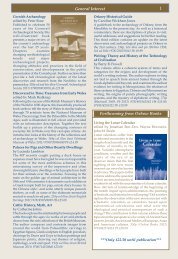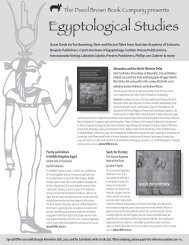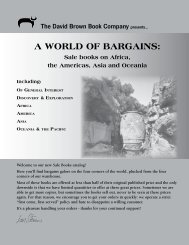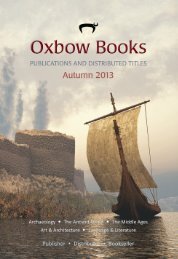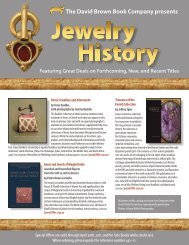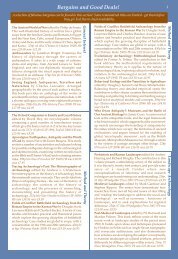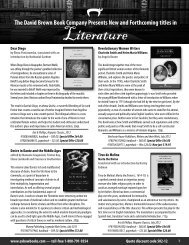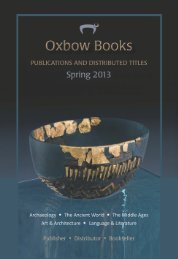New Distributed Titles Fall 2009 - Oxbow Books
New Distributed Titles Fall 2009 - Oxbow Books
New Distributed Titles Fall 2009 - Oxbow Books
Create successful ePaper yourself
Turn your PDF publications into a flip-book with our unique Google optimized e-Paper software.
The Athenian Agora<br />
Site Guide (Fifth Edition)<br />
by John McK Camp II<br />
The Athenian Decadrachm<br />
by Wolfgang Fischer-Bossert<br />
This volume represents a huge advance on the previous study of the material.<br />
Fischer-Bossert has collected more than three times as many specimens as were<br />
known to Starr, and has provided a full account of the known forgeries drawn from<br />
the photo-files of major dealers, scholars and Museums. This is an indispensable<br />
work for all interested in the coinage and history 5th-century Athens. In addition, its<br />
judicious discussion of the history of the forgery of these remarkable coins will make<br />
this volume a handbook for all serious collectors of ancient Greek coinage.<br />
105p, 41 pls, hardback, 9780897223096, $95.00, American Numismatic Society,<br />
February <strong>2009</strong>, Numismatic Notes and Monographs 168.<br />
Graeco-Roman Slave Markets – Fact or Fiction?<br />
by Monika Trümper<br />
This book critically examines the existence and identification of purpose-built<br />
slave markets in the Graeco-Roman world from a cross-cultural perspective. It<br />
investigates whether certain ancient monuments were designed specifically<br />
for use as slave markets and whether they required special equipment and<br />
safety precautions, allowing them to be clearly distinguished from other nonspecific<br />
commercial buildings and marketplaces of the Graeco-Roman world.<br />
Selected parallels, namely slave markets in Istanbul, Marrakesh, Cairo, Havana,<br />
Charleston, and <strong>New</strong> Orleans, are analyzed. This is followed by a brief discussion<br />
of ancient written sources on slave markets, focusing on what the texts<br />
reveal about the existence, design, and requirements of ancient slave markets.<br />
A major part of this book is dedicated to a critical reexamination of all eight<br />
ancient buildings that have been identified as slave markets so far. The conclusion<br />
includes a short comparison of modern and alleged ancient slave markets<br />
and finally answers the question of whether, to date, ancient slave markets are<br />
an archaeological fact or fiction.<br />
160p, 41 b/w illus, 8 col pls, hardback, 9780977409488, $45.00,<br />
Bannerstone Press, December <strong>2009</strong>.<br />
This definitive guide to the archaeological remains viewable in the civic and<br />
commercial center of ancient Athens is an essential companion to the interested<br />
visitor, or to students of the topography of the classical city. A fold-out<br />
map provides an overview of the site, keyed to descriptions and plans of every<br />
monument still visible. The fifth edition takes full account of both new discoveries<br />
and recent scholarship. It is intended for visitors actually touring the site,<br />
and is arranged topographically, monument by monument.<br />
208p, 73 plans, 13 col & 45 b/w figs, paperback, 9780876616574, $19.95,<br />
American School of Classical Studies at Athens, September <strong>2009</strong>.<br />
classical archaeology<br />
Pichvnari II<br />
The Classical World in the Eastern<br />
Black Sea Area – The Fifth Century BC<br />
Greek Necropolis at Pichvnari<br />
by Amiran Kakhidze<br />
The British-Georgian Pichvnari Expedition has<br />
been active since 1998, excavating cemeteries<br />
and settlement of the Greco-Colchian emporion<br />
at Pichvnari. This volume deals with some of the<br />
work done at Pichvnari between 1960 and 1989.<br />
Although small-scale fieldwork was carried out in<br />
1953 and 1956, it was only in 1960 that large-scale excavation began, conducted by<br />
the N. Berdzenishvili Batumi Research Institute of the Georgian Academy of Sciences.<br />
Perhaps the most significant contribution was the investigation of the Greek cemetery,<br />
which, if it is indeed truly Greek, as we believe it to be, constitutes the largest ethnic<br />
Greek necropolis in the eastern Black Sea region. English and Georgian text.<br />
308p, 14 col & 86 b/w pls, hardback, 9781854442239, $70.00, Ashmolean Museum /<br />
Batumi Archaeological Museum, December 2007.<br />
Ein Trojanischer Federkrieg<br />
Die Auseinandersetzungen zwischen<br />
Ernst Boetticher und Heinrich Schliemann<br />
by Michaela Zavadil<br />
In December 1883, a dispute began between Ernst<br />
Boetticher and Heinrich Schliemann over the latter’s<br />
interpretation of his research in Troy. Boetticher was<br />
convinced that Schliemann had misinterpreted the<br />
excavation results and had not found a settlement, but<br />
a fire-necropolis. The monograph examines the history<br />
of this conflict, which continued even after Schliemann’s death in 1890. German text.<br />
462p, paperback, 9783700165057, $96.00(s), Austrian Academy of Sciences,<br />
October <strong>2009</strong>, Veröffentlichungen der Mykenischen Kommission.<br />
www.dbbconline.com 27




